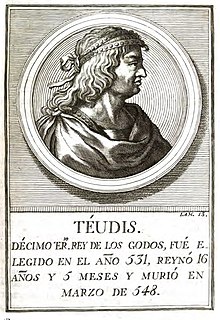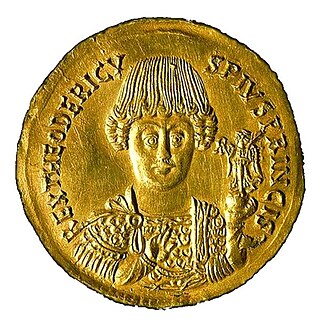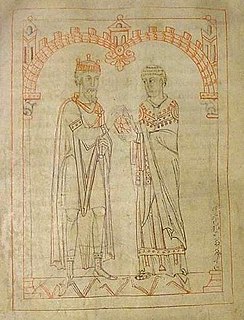
This is a list of the royal consorts of the Kingdom of Galicia . It is, in part, a continuation of the list of Asturian consorts.

This is a list of the royal consorts of the Kingdom of Galicia . It is, in part, a continuation of the list of Asturian consorts.
| Name | Father | Birth | Marriage | Became Consort | Ceased to be Consort | Death | Spouse |
|---|---|---|---|---|---|---|---|
| Elvira Menéndez of Coimbra [1] [2] | Hermengildo Gutierrez, Count of Coimbra | 864-75 | 890-900 | 20 December 910 husband's ascession | 914 husband's ascession to León | Ordoño II | |
| Goto Muñiz | Munio Gutiérrez, Lord of Amaía | - | before 927 | July 925 husband's accession | after 10 June 929 husband's death | after 1 March 963 | Sancho I Ordóñez |

Amalaric was king of the Visigoths from 522 until his death in battle in 531. He was a son of king Alaric II and his first wife Theodegotha, daughter of Theoderic the Great.

The Ostrogoths were a Roman-era Germanic people. In the 5th century, they followed the Visigoths in creating one of the two great Gothic kingdoms within the Roman Empire, based upon the large Gothic populations who had settled in the Balkans in the 4th century, having crossed the Lower Danube. While the Visigoths had formed under the leadership of Alaric I, the new Ostrogothic political entity which came to rule Italy was formed in the Balkans under the influence of the Amal Dynasty, the family of Theodoric the Great.

Theodoricthe Great, also called Theodoric the Amal, was king of the Ostrogoths (471–526), and ruler of the independent Ostrogothic Kingdom of Italy between 493 and 526, regent of the Visigoths (511–526), and a patrician of the East Roman Empire. As ruler of the combined Gothic realms, Theodoric controlled an empire stretching from the Atlantic Ocean to the Adriatic Sea. Though Theodoric himself only used the title 'king' (rex), some scholars characterize him as a Western Roman Emperor in all but name, since he ruled large parts of the former Western Roman Empire, had received the former Western imperial regalia from Constantinople in 497, and was referred to by the title augustus by some of his subjects.

Theodoric is a Germanic given name. First attested as a Gothic name in the 5th century, it became widespread in the Germanic-speaking world, not least due to its most famous bearer, Theodoric the Great, king of the Ostrogoths.

Flavius Ardabur Aspar was an Eastern Roman patrician and magister militum of Alanic-Gothic descent. As the general of a Germanic army in Roman service, Aspar exerted great influence on the Eastern Roman Emperors for half a century, from the 420s to his death in 471, through the reigns of Theodosius II, Marcian and Leo I, who, in the end, had him killed. His death led to the ending of the Germanic domination of Eastern Roman policy.

Theudis, was king of the Visigoths in Hispania from 531 to 548.
The Amali – also called Amals, Amalings or Amalungs – were a leading dynasty of the Goths, a Germanic people who confronted the Roman Empire during the decline of the Western Roman Empire. They eventually became the royal house of the Ostrogoths and founded the Ostrogothic Kingdom of Italy.

The Ostrogothic Kingdom, officially the Kingdom of Italy, was established by the Germanic Ostrogoths in Italy and neighboring areas from 493 to 553.
Amalafrida, was the daughter of Theodemir, king of the Ostrogoths, and his wife Erelieva. She was the sister of Theodoric the Great, and mother of Theodahad, both of whom also were kings of the Ostrogoths.
Amalaberga was the daughter of Amalafrida, daughter of Theodemir, king of the Ostrogoths.

Rechiar or Rechiarius was the Suevic king of Gallaecia from 448 until his death. He was the first Chalcedonian Christian (Catholic) Germanic king in Europe and one of the most innovative and belligerent of the Suevi monarchs. Despite his orthodox Christianity, Hydatius, the contemporary bishop and chronicler from Galicia who is the sole contemporary source for biographical details of Rechiar, established his reputation as that of a barbarian with little sense of Roman law, culture, or custom.

The Kingdom of the Suebi, also called the Kingdom of Gallæcia or Suebi Kingdom of Gallæcia, was a Germanic post-Roman kingdom that was one of the first to separate from the Roman Empire. Based in the former Roman provinces of Gallaecia and northern Lusitania, the de facto kingdom was established by the Suebi about 409, and during the 6th century it became a formally declared kingdom identifying with Gallaecia. It maintained its independence until 585, when it was annexed by the Visigoths, and was turned into the sixth province of the Visigothic Kingdom in Hispania.

Miro was the Suebian King of Galicia from 570 until his death in 583. His reign was marked by attempts to forge alliances with other Chalcedonian Christian nations with the goal of checking the power of the Arian Visigoths under Leovigild. During his reign relations were established with both Francia and the Byzantine Empire and the kingdom reached its zenith, but it collapsed within three years of his death.

A Struggle for Rome is a historical novel written by Felix Dahn.

Theodoric I was the King of the Visigoths from 418 to 451. Theodoric is famous for his part in defeating Attila at the Battle of the Catalaunian Plains in 451, where he was killed.

The Ostrogothic Papacy was a period from 493 to 537 where the papacy was strongly influenced by the Ostrogothic Kingdom, if the pope was not outright appointed by the Ostrogothic King. The selection and administration of popes during this period was strongly influenced by Theodoric the Great and his successors Athalaric and Theodahad. This period terminated with Justinian I's (re)conquest of Rome during the Gothic War (535–554), inaugurating the Byzantine Papacy (537-752).